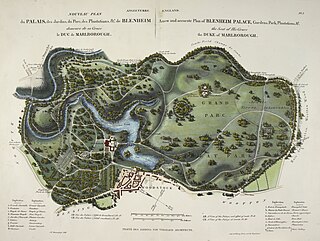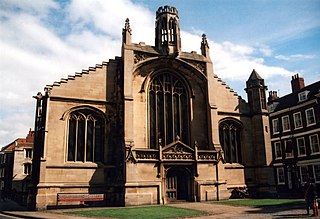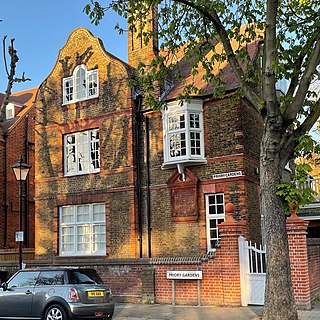
Sir Charles BarryFRS RA was a British architect, best known for his role in the rebuilding of the Palace of Westminster in London during the mid-19th century, but also responsible for numerous other buildings and gardens. He is known for his major contribution to the use of Italianate architecture in Britain, especially the use of the Palazzo as basis for the design of country houses, city mansions and public buildings. He also developed the Italian Renaissance garden style for the many gardens he designed around country houses.

In the United Kingdom, a listed building is a structure of particular architectural and/or historic interest deserving of special protection. Such buildings are placed on one of the four statutory lists maintained by Historic England in England, Historic Environment Scotland in Scotland, Cadw in Wales, and the Northern Ireland Environment Agency in Northern Ireland. These have classifications that differ between: England and Wales, Scotland and Northern Ireland. The term has also been used in the Republic of Ireland, where buildings are protected under the Planning and Development Act 2000, although the statutory term in Ireland is "protected structure".
The Council for British Archaeology (CBA) is an educational charity established in 1944 in the UK. It works to involve people in archaeology and to promote the appreciation and care of the historic environment for the benefit of present and future generations. It achieves this by promoting research, conservation and education, and by widening access to archaeology through effective communication and participation.

The Royal Institute of British Architects (RIBA) is a professional body for architects primarily in the United Kingdom, but also internationally, founded for the advancement of architecture under its royal charter granted in 1837, three supplemental charters and a new charter granted in 1971.

The Society for the Protection of Ancient Buildings (SPAB) is an amenity society founded by William Morris, Philip Webb, and others in 1877 to oppose the destructive 'restoration' of ancient buildings occurring in Victorian England. "Ancient" is used here in the wider sense rather than the more usual modern sense of "pre-medieval."
Thomas Rickman was an English architect and architectural antiquary who was a major figure in the Gothic Revival. He is particularly remembered for his Attempt to Discriminate the Styles of English Architecture (1817), which established the basic chronological classification and terminology that are still in widespread use for the different styles of English medieval ecclesiastical architecture.
The Royal Incorporation of Architects in Scotland (RIAS) is the professional body for architects in Scotland.

Historic garden conservation is a specialised type of historic preservation and conservation or restoration concerned with historical and landmark gardens and designed landscapes.

St Michael le Belfrey is an Anglican church in York, England. It is situated at the junction of High Petergate and Minster Yard, directly opposite York Minster, in the centre of the city.

The Victorian Society is a UK charity and amenity society that campaigns to preserve and promote interest in Victorian and Edwardian architecture and heritage built between 1837 and 1914 in England and Wales. As a statutory consultee, by law it must be notified of any work to a listed building which involves any element of demolition or structural alteration.
The Ancient Monuments Society (AMS) is a learned society and registered charity in England and Wales, founded in 1924 "for the study and conservation of ancient monuments, historic buildings and fine old craftsmanship". Since October 2021, the organisation's working name has been Historic Buildings & Places (HB&P).
Save Britain's Heritage is a British charity, created in 1975 by a group of journalists, historians, architects, and planners to campaign publicly for endangered historic buildings. It is also active on the broader issues of preservation policy. SAVE is a registered charity governed by a board of trustees.

The Twentieth Century Society, founded in 1979 as The Thirties Society, is a British charity that campaigns for the preservation of architectural heritage from 1914 onwards. It is formally recognised as one of the National Amenity Societies, and as such is a statutory consultee on alterations to listed buildings within its period of interest.
Historic England is an executive non-departmental public body of the British Government sponsored by the Department for Culture, Media and Sport. It is tasked with protecting the historic environment of England by preserving and listing historic buildings, scheduling ancient monuments, registering historic parks and gardens and by advising central and local government.
An annual Heritage at Risk Register is published by Historic England. The survey is used by national and local government, a wide range of individuals and heritage groups to establish the extent of risk and to help assess priorities for action and funding decisions. This heritage-at-risk data is one of the UK government's official statistics.

The Gardens Trust is a national membership organisation in the United Kingdom established to study the history of gardening and to protect historic gardens.
Sir Donald William Insall is a British architect, conservationist and author, who has been described as "one of the leading conservation architects of his generation". He is the founder of the architectural, conservation and architectural consultancy practice, Donald Insall Associates.
In England and Wales, an amenity society is an organisation which monitors planning and development.
Donald Insall Associates is a firm of architects, designers and historic building consultants in the United Kingdom.
James St Clair Wade is a British architect. He was educated at Shrewsbury School, and was a scholar at St John's College, Cambridge before attending Harvard University.









